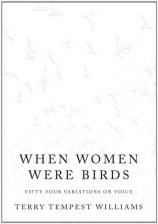Reading Group Guide
Discussion Questions
When Women Were Birds: Fifty-four Variations on Voice

1. Terry Tempest Williams describes the gifts of her relationships with her mother, Diane, and grandmother Mimi. What legacies have been passed to you by the women in your family?
2. Discuss the beauty and symbolism of birds, including the various birds described in the book, from the owl to the falcon to the thrush and the bunting. What would your life look like if you could “fly”? What songs would you sing at dawn and dusk?
3. When Women Were Birds explores the power of silence and emptiness, with analogies that include John Cage’s music and Robert Rauschenberg’s White Paintings. How did you interpret Diane’s blank journals? What does your interpretation say about you? Which of Williams’s many interpretations resonates with you the most?
4. In chapter 31, Williams reveals that a man named Joseph terrorized her when she was a teaching assistant in the Sawtooth Wilderness of Idaho. How would you answer the questions she poses in that chapter: What are the consequences when we go against our instincts? What are the consequences of not speaking out? What are the consequences of guilt, shame, and doubt?
5. The owners of the Jeffs school forbade Williams to practice environmentalism or teach biology. How did Williams develop the courage to become an activist, despite so many restrictions on her freedom early in her career? What factors lead to engagement, personal as well as political?
6. Discuss the landscapes that Williams calls home. What are the patterns that connect throughout the book regarding our relationship toward place? What different meanings do Utah and New York have for her? The desert and the sea? How does home contribute to voice?
7. What role does the Mormon church play in Williams’s life? How is her depiction of the LDS religion and its influence different from others you’ve seen?
8. How is Williams transformed by her night in jail (chapter 41)? What common threads run through the factors she lists: suspended license, no money for the fine, thinking she can cope with being locked up for just one night, believing that she deserves to be punished? Imprisonment and freedom are parallel themes within When Women Were Birds. Where else does this imagery emerge?
9. Shadow and light loom large in When Women Were Birds. Williams also appreciates the Japanese greeting “How is your honorable shadow?” and recounts Strauss’s opera Die Frau Ohne Schatten (The Woman Without a Shadow). How do these echoes of identity and psychological inquiry come to life in the book?
10. How does Williams’s relationship with her father compare to your own relationship with your dad? What did her father teach her about men?
11. What does the book say about the experience of solitude versus being in partnership? How would you describe Terry and Brooke’s marriage? What levels of self-awareness does Williams receive from Brooke and Louis? How does her definition of love develop throughout her lifetime?
12. How was your reading affected by the book’s form and design, with passages enough to carry you through a year and chapters that bear unique, variable patterns? What do these precise pieces create as a whole?
13. In chapter 54 (both versions of it, LIV and LIV[E]), Williams must face the uncertainty (of mysteries) of mortality, but she acknowledges the empty page that accompanies the start of each new day. What inspiration do you take from these scenes? How can the book help readers reclaim a voice?
14. What is the relationship between voice and silence? What do you think Williams meant when she said, “If only my mother had known I was her sister instead of her daughter”?
15. Discuss this book’s relationship to Williams’s previous books that you have read, particularly Refuge. In what ways might this book be its sequel? How has Williams’s voice changed throughout the years? How do you see your own voice evolving? Collectively, what freedoms do Terry Tempest Williams’s writings provide?
When Women Were Birds: Fifty-four Variations on Voice
- Publication Date: April 10, 2012
- Hardcover: 224 pages
- Publisher: Sarah Crichton Books
- ISBN-10: 0374288976
- ISBN-13: 9780374288976








